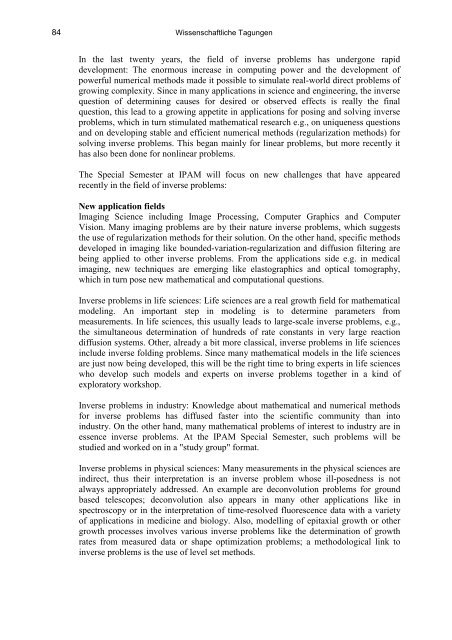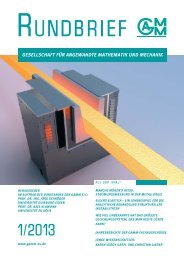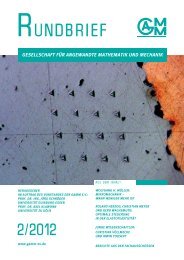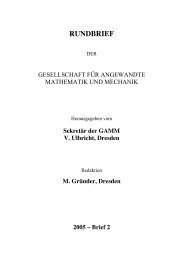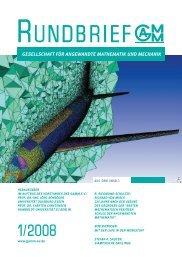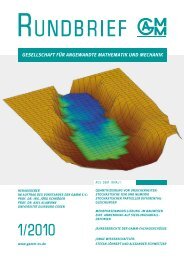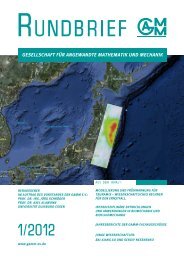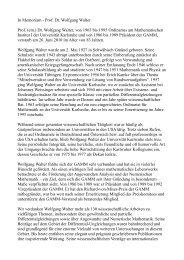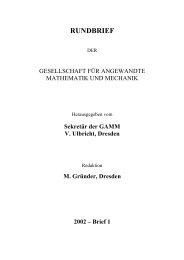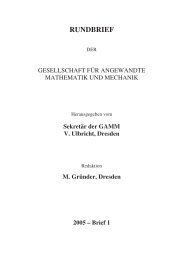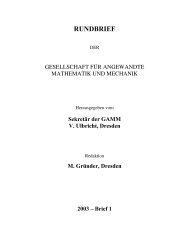GAMM Rundbrief 2002/Heft 2
GAMM Rundbrief 2002/Heft 2
GAMM Rundbrief 2002/Heft 2
You also want an ePaper? Increase the reach of your titles
YUMPU automatically turns print PDFs into web optimized ePapers that Google loves.
84 Wissenschaftliche Tagungen<br />
In the last twenty years, the field of inverse problems has undergone rapid<br />
development: The enormous increase in computing power and the development of<br />
powerful numerical methods made it possible to simulate real-world direct problems of<br />
growing complexity. Since in many applications in science and engineering, the inverse<br />
question of determining causes for desired or observed effects is really the final<br />
question, this lead to a growing appetite in applications for posing and solving inverse<br />
problems, which in turn stimulated mathematical research e.g., on uniqueness questions<br />
and on developing stable and efficient numerical methods (regularization methods) for<br />
solving inverse problems. This began mainly for linear problems, but more recently it<br />
has also been done for nonlinear problems.<br />
The Special Semester at IPAM will focus on new challenges that have appeared<br />
recently in the field of inverse problems:<br />
New application fields<br />
Imaging Science including Image Processing, Computer Graphics and Computer<br />
Vision. Many imaging problems are by their nature inverse problems, which suggests<br />
the use of regularization methods for their solution. On the other hand, specific methods<br />
developed in imaging like bounded-variation-regularization and diffusion filtering are<br />
being applied to other inverse problems. From the applications side e.g. in medical<br />
imaging, new techniques are emerging like elastographics and optical tomography,<br />
which in turn pose new mathematical and computational questions.<br />
Inverse problems in life sciences: Life sciences are a real growth field for mathematical<br />
modeling. An important step in modeling is to determine parameters from<br />
measurements. In life sciences, this usually leads to large-scale inverse problems, e.g.,<br />
the simultaneous determination of hundreds of rate constants in very large reaction<br />
diffusion systems. Other, already a bit more classical, inverse problems in life sciences<br />
include inverse folding problems. Since many mathematical models in the life sciences<br />
are just now being developed, this will be the right time to bring experts in life sciences<br />
who develop such models and experts on inverse problems together in a kind of<br />
exploratory workshop.<br />
Inverse problems in industry: Knowledge about mathematical and numerical methods<br />
for inverse problems has diffused faster into the scientific community than into<br />
industry. On the other hand, many mathematical problems of interest to industry are in<br />
essence inverse problems. At the IPAM Special Semester, such problems will be<br />
studied and worked on in a "study group" format.<br />
Inverse problems in physical sciences: Many measurements in the physical sciences are<br />
indirect, thus their interpretation is an inverse problem whose ill-posedness is not<br />
always appropriately addressed. An example are deconvolution problems for ground<br />
based telescopes; deconvolution also appears in many other applications like in<br />
spectroscopy or in the interpretation of time-resolved fluorescence data with a variety<br />
of applications in medicine and biology. Also, modelling of epitaxial growth or other<br />
growth processes involves various inverse problems like the determination of growth<br />
rates from measured data or shape optimization problems; a methodological link to<br />
inverse problems is the use of level set methods.


